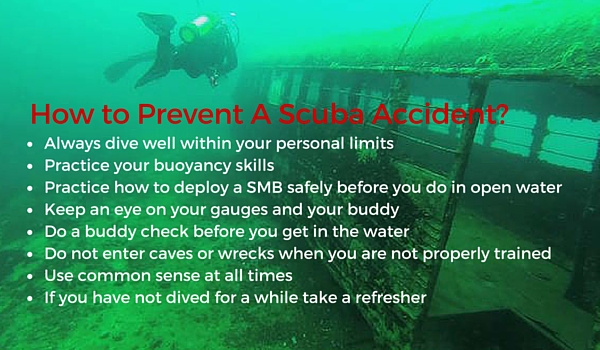## What to Do If You Experience a Scuba Diving Accident
Scuba diving is a generally safe activity, but accidents can happen. Being prepared can help you protect your safety and increase your chances of survival. This article provides a comprehensive guide on the necessary steps to take if faced with a scuba diving emergency.
### **Before the Dive:**
– **Obtain Proper Training:** Complete a recognized scuba diving certification and stay up-to-date with the latest safety protocols.
– **Conduct Pre-Dive Checks:** Thoroughly inspect your gear, including regulators, hoses, and buoyancy compensator device (BCD).
– **Plan Your Dive:** Choose a dive site appropriate for your skill level and plan your dives carefully.
### **In the Event of an Accident:**
#### **1. Stay Calm:**
Panic can lead to poor decisions. Take a deep breath, remain calm, and assess the situation.
#### **2. Signal for Help:**
– Use the underwater distress signal: repeatedly waving one arm over your head.
– If possible, use an emergency surfacing device (DSMB) to signal your location on the surface.
– If you have a whistle or horn, use it to attract attention.
#### **3. Ascend Slowly:**
– Do not attempt a rapid ascent. Slow, controlled ascents are crucial to avoid decompression sickness (DCS).
– If possible, use your BCD to control your ascent rate.
– If you have an emergency oxygen unit, use it during the ascent.
#### **4. Treat Injuries:**
– If you or a buddy suffers any injuries, administer first aid as necessary.
– Stop bleeding, immobilize broken bones, and provide CPR if needed.
#### **5. Contact Emergency Services:**
– Once back on the surface, seek immediate medical attention.
– Call the local Coast Guard or emergency services number.
#### **6. Report the Incident:**
– Report the accident to your dive operator, the relevant dive agency, and your insurance company.
– Provide a detailed account of what happened, including the cause and any injuries sustained.
### **Specific Emergencies:**
#### **1. Loss of Buoyancy:**
– Try to regain your buoyancy using your BCD.
– If unable, inflate your dry suit or use any available airbags.
– Ascend slowly and controlledly, using your breath to maintain positive buoyancy.
#### **2. Air Exhaustion:**
– This can occur if you run out of air or experience a regulator failure.
– Signal for help and ascend slowly.
– Share air with a buddy if possible, using an octopus regulator.
#### **3. Decompression Sickness (DCS):**
– DCS can occur from rapid ascents.
– Symptoms include joint pain, numbness, and paralysis.
– Seek immediate medical attention and undergo recompression therapy if necessary.
#### **4. Nitrogen Narcosis:**
– Narcosis can occur at depths of 100 feet or more.
– Symptoms include disorientation, euphoria, and impaired judgment.
– Ascend slowly and controlledly to reduce the effects of narcosis.
#### **5. Panic:**
– Panic can lead to poor decisions and worsen the situation.
– Try to stay calm, focus on your breathing, and follow the emergency procedures.
### **Additional Tips:**
– **Carry a Dive Computer:** Monitor your depth and dive time to ensure proper decompression and avoid emergencies.
– **Buddy System:** Dive with a buddy and stay close during the dive.
– **Practice Emergency Drills:** Regularly practice emergency procedures to improve your response time.
– **Have a Plan:** Before each dive, discuss with your buddy what to do in the event of an emergency.
– **Stay Informed:** Keep up-to-date with the latest scuba diving safety regulations and best practices.
Remember, remaining calm and following the proper procedures can significantly improve your chances of surviving a scuba diving accident. By being prepared, you can enjoy this thrilling activity safely and confidently.
